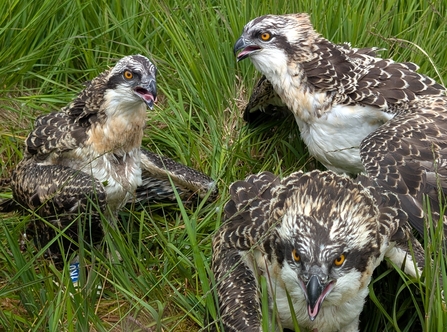
A licenced bird ringer carried out the ringing of three osprey chicks at Foulshaw Moss Nature Reserve recently © Cumbria Wildlife Trust

A licenced bird ringer carried out the ringing of three osprey chicks at Foulshaw Moss Nature Reserve recently © Cumbria Wildlife Trust
Three osprey chicks at Foulshaw Moss Nature Reserve, two male and one female, were recently tagged and weighed by a licenced and experienced bird ringer, and given a coloured ID leg ring.
The two males were named as 7K0 and 7K2, the female as 7K1. The female is the largest, weighing 1.790kg with the two males slightly smaller, at 1.480kg and 1.560kg.
The reason for ringing and tagging the birds is so that we can track their movements and understand their life history. They will soon leave the nature reserve and migrate south to the Iberian Peninsula or West Africa.
Paul Waterhouse, Reserves Officer for Cumbria Wildlife Trust said: “This has been a very special year for us: for the first time, we’ve had breeding ospreys on two nests at Foulshaw Moss. Our ‘regular’ pair, Blue 35 and White YW, who have bred here successfully since 2014, were joined on a second nest by a pair of newcomers, Blue 476 and Blue 717
“So far only the three older chicks (on Blue 35 and White YW nest) have been ringed and tagged. The new breeding pair have had mixed success, which is not unusual in the first year: there is currently one surviving chick on their nest, which will be ringed at a later date, as it hatched later. We organise the ringing when the chicks are about five or six weeks old, as they can’t yet fly, but they’re almost fully grown.”
Paul explained: “As the osprey is a Schedule 1 protected species, only those with a licence from the British Trust for Ornithology (BTO) are permitted to approach and handle the birds. We keep the process as short and stress-free as possible, with the minimum of handling and time away from normal routine for the birds.”
Our live osprey cam is still trained on nest 1 (Blue 35 and White YW), so you can keep a close eye on the chicks for the rest of the season, till the ospreys migrate in September. Follow #FoulshawOspreys to keep up with the latest news from both nests.
The second nest is quite close to the boardwalk and is vulnerable to disturbance, so we ask visitors to be aware of this when they visit. We've built a hide nearby to view the new nest from and ask everyone to use this hide respectfully, taking other visitors’ experiences into account.
The car park at Foulshaw Moss Nature Reserve is quite small and gets full quickly. If you’re able to, please access it via public transport – you’ll find information about this on our website. There are also bike racks available.
If you do arrive in a car and find that the car park is full, please return at a later time or date. The access road to the nature reserve is narrow and doesn’t have passing places, so please drive carefully and expect that you may need to reverse to help others pass.
Blue 35 and White YW first came to Foulshaw Moss Nature Reserve in 2013 after it was transformed by a large-scale habitat restoration programme. Over a decade or so, the 900-acre site, which had been drained and used for commercial forestry, was returned to the healthy wetland you see now, which is teeming with wildlife.
Foulshaw Moss Nature Reserve is open daily, free of charge. It’s located off the A590 near Witherslack.
Use #FoulshawOspreys to join the osprey conversation on social.